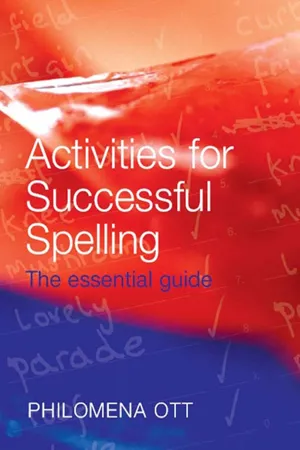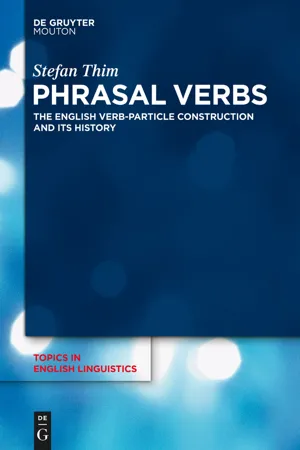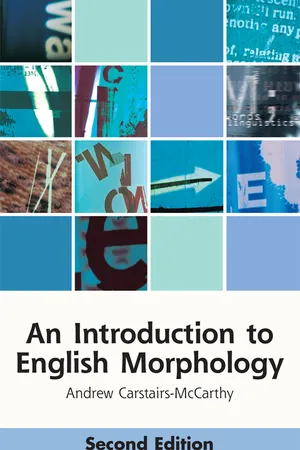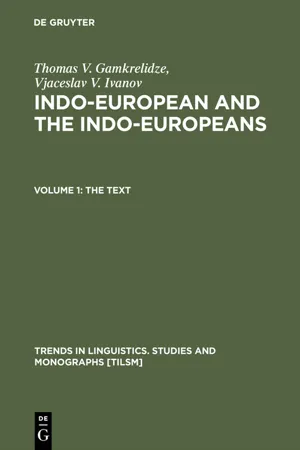Languages & Linguistics
Anglo Saxon Roots and Prefixes
Anglo-Saxon roots and prefixes are the foundation of many English words, contributing to the language's rich vocabulary. These elements, derived from Old English, often convey meanings related to time, space, and relationships. Understanding these roots and prefixes can help in deciphering the meanings of unfamiliar words and in building a stronger grasp of the English language.
Written by Perlego with AI-assistance
Related key terms
1 of 5
5 Key excerpts on "Anglo Saxon Roots and Prefixes"
- eBook - ePub
Activities for Successful Spelling
The Essential Guide
- Philomena Ott(Author)
- 2012(Publication Date)
- Routledge(Publisher)
5 How to Manage Root Words, Prefixes and Suffixes Skilfully The aims of this chapterIdentifying root words and affixes helps to develop readers’ awareness and ability with phonological skills. It heightens their consciousness of the beginning, middle and endings of words as well as the basic spelling elements and patterns. Those with good visual skills learn by grafting on affixes to root words and by memorising the word patterns. Strong verbalisers and those with good auditory and language skills deepen their understanding of word structure and spelling when using and learning the meanings of Anglo-Saxon, Greek and Latin derivatives. The use of multi-sensory strategies helps to compensate for poor visual skills, as well as helping those with poor phonological skills. Those who have good kinaesthetic skills learn by counting and dividing words into roots, prefixes and suffixes; they can then synthesise these syllables into words when reading and spelling.Specific knowledge and understanding of affixes helps to lessen the fear of spelling long words, many of which follow a reliable sound-to-symbol match. Adding prefixes to words follows some clear-cut guidelines and rules.Suffixes carry out many important functions, including grammatical and syntactic functions. The rules for adding suffixes are clear-cut, specific, reliable and frequently used. Studying them pays handsome dividends for all spellers, providing many opportunities to boost and enrich vocabulary. The Rose Review pointed out the importance of ’linguistic’ comprehension which involves the interpretation of words, sentences and discourse’ which each Section provides. - eBook - PDF
Phrasal Verbs
The English Verb-Particle Construction and its History
- Stefan Thim(Author)
- 2012(Publication Date)
- De Gruyter Mouton(Publisher)
in particular the loss of native prefixes in the North Germanic languages, where later new prefixes were formed on the basis of German loans, while in the Continental West Ger-manic languages almost identical sets of Latin- or Greek-derived prefixes were adopted despite the continued productivity of native prefixes. This is not to say, however, that the degree of integration of borrowed items in these languages were not different from each other and from English (see in particular the discussion in Lutz 2002b and 2008 and the references given there). These conclusions have been obscured so far by the mode of presenta-tion of borrowings and prefixes in the handbooks, where Germanic-based prefixes are usually treated separately from Romance-based prefixes, which are usually ascribed to the Middle English period because the borrowed verbs containing these prefixes are mostly first attested in Middle English. In the English research tradition, Germanic prefixes are treated as a parti-cularly Old English phenomenon, Romance prefixes in the context of Middle English borrowing, and ‘phrasal verbs’ as a new and particularly English phenomenon. The changes in word order are usually almost entirely neglected by studies of word formation, although these changes play a central role in the development of verbal prefixation and in the emergence of phrasal verbs. Thus, what is missing is a treatment of the dif-ferent types of word formation in a coherent and systematically related way. Such a discussion would also have to describe the historical develop-ment of new particle types, including those with a Romance etymology (e.g. apart ), the persistence of some Old English particles and the emer-gence of new, Germanic-based prefixes in Middle English, a topic which so far has been almost entirely neglected in the literature. - eBook - ePub
Indo-European Language and Culture
An Introduction
- Benjamin W. Fortson, IV(Authors)
- 2011(Publication Date)
- Wiley-Blackwell(Publisher)
4 Proto-Indo-European Morphology: Introduction The Root and Indo-European Morphophonemics4.1. Morphology is the study of the rules governing word-formation and inflection; the term also refers to the set of rules themselves in a given language. Words consist of one or more morphemes , the smallest meaningful units in a language. Morphemes can be whole words (e.g. Eng. bed , succotash , sarsaparilla ) or parts of words such as affixes (e.g. the Eng. prefix un- and suffix -ed ). In many languages, some morphemes can appear in different forms called allomorphs depending on their phonetic or morphological context (e.g. the Eng. prefix in- ‘not’ can appear as in- , im- , il- , ir- , as in in-credible , im-perfect , il-logical , ir-replaceable ). The morphophonemics of a language is the set of rules determining the distribution of allomorphs.A root is a morpheme from which semantically related words can be derived. The root itself does not usually exist as an independent form, but carries the semantic core of any word derived from it. In English, for example, the words commit , emit , transmit , remission , and missive are all derived from a root mit (borrowed from Latin) that conveys the basic meaning ‘send’. When reconstructing the vocabulary of PIE, typically it is roots that are reconstructed in the first instance (see below, 4.11, for more on this). Since they did not stand alone, they are conventionally cited with an added hyphen (e.g. *sed- ‘sit’), indicating that suffixes had to be added to form free-standing words. Besides the attachment of suffixes (and sometimes, but more rarely, prefixes and infixes – affixes added into the middle of a root), word-formation in PIE often required modification of the shape of the root itself, in ways to be discussed further below.Unlike sounds, morphemes do not necessarily change in an exceptionless and regular way over time. Changes may sometimes affect whole morphological systems, but very commonly they affect only individual words, as when the old irregular plural kine was replaced by the regular plural cows - eBook - PDF
An Introduction to English Morphology
Words and Their Structure (2nd edition)
- Andrew Carstairs-McCarthy(Author)
- 2017(Publication Date)
- EUP(Publisher)
Classify these affixes in terms of origin, distinguishing between those borrowed from Latin or French and those inherited from Germanic. (Consult a good dictionary if necessary.) 120 AN INTRODUCTION TO ENGLISH MORPHOLOGY 2. Are the bases to which each affix is attached usually bound or free? 3. How likely is each affix to appear in neologisms, as defined in Chapter 8? For this purpose, assume that the following imaginary words have very recently come into use (perhaps borrowed from a little-known dialect), and are therefore potential bases for the forma- tion of neologisms: • bledge (noun) ‘sensation of nausea’, as in Her bledge returned after she had drunk the soup • grint (verb) ‘flatten underfoot’, as in Acorns are easier to grint than horse chestnuts • dorben (adjective) ‘wary, cautious’, as in They are thoroughly experi- enced and dorben mountaineers. If you are not a native speaker of English, ask a friend to judge whether various root–suffix combinations seem plausible, given the word class and meaning of each imaginary word. 4. To what extent do the answers to questions 1, 2 and 3 yield overlap- ping classifications? Comment on the degree of overlap. 5. What are the Greek-derived technical terms that have the follow- ing meanings? Identify the roots (combining forms or free forms) in them, with their meanings. (You may find it helpful to consult a thesaurus, such as Roget’s Thesaurus, or an encyclopedia.) (a) ‘study of skin diseases’ (b) ‘red blood cell’ (c) ‘flying dinosaur with wing membrane connected to an elongated finger’ (d) ‘situation where political power is in the hands of a small ruling class; members of that class (collectively)’ (e) ‘line on a weather map connecting places with equal temperature’ (f) ‘round submarine vessel for exploring the depths of the ocean’ 6. - eBook - PDF
Indo-European and the Indo-Europeans
A Reconstruction and Historical Analysis of a Proto-Language and Proto-Culture. Part I: The Text. Part II: Bibliography, Indexes
- Thomas V. Gamkrelidze, Vjaceslav V. Ivanov, Nichols Johanna(Authors)
- 2010(Publication Date)
- De Gruyter Mouton(Publisher)
Chapter Four The structure of the Indo-European root 4.1. Canonical forms of root morphemes 4.1.1. The structural types of morphemes in Indo-European: root and suffix The analysis of the Indo-European phonological system given above distin-guishes the categories of consonant, vowel, laryngeal, and sonant, and describes the mechanism of vowel ablaut. With this system we can reconstruct the basic structural types, or canonical forms, for morphemes in late Proto-Indo-Euro-pean and establish rules for their syntagmatic combination. For late Proto-Indo-European of the period just before its breakup, several structural types of morphemes can be reconstructed. For a structural descrip-tion it is useful to distinguish two classes of morphemes: roots and affixes. The root is that segment of a wordform that remains after the affixal elements have been removed from reconstructed protoforms. The affixal elements include not only productive morphological devices but also certain fossilized formatives which can be segmented off on the evidence of comparison to cognates in other languages, where the formative in question contrasts with others. For instance, by comparing the cognates Lat. hiems 'winter', Skt. héman 'in winter', Gk. kheimôn 'winter storm, winter', Hitt. gimmant-'winter', and Avest. zayan-'winter' we can reconstruct the Indo-European bases *ghei- and *gheim-. We can segment off an affixal element *-m-, which contrasts with zero in *g h ei-. On these grounds, *g h ei- is the root, since it underlies all the derivatives of this form. Similarly, comparison of the cognates Skt. náktam 'at night', Lat. nox, gen. noctis, Gk. núks, gen. nuktós 'night', Hitt. nekut-'eve-ning', neku-zzi 'it gets dark' yields the reconstructed protoforms * n e / o k h o t h -and * n e k h o . , where *-th-can be segmented off as an affix and * n e k h o -, which is found in all the formations of this group, can be taken as the root.
Index pages curate the most relevant extracts from our library of academic textbooks. They’ve been created using an in-house natural language model (NLM), each adding context and meaning to key research topics.




